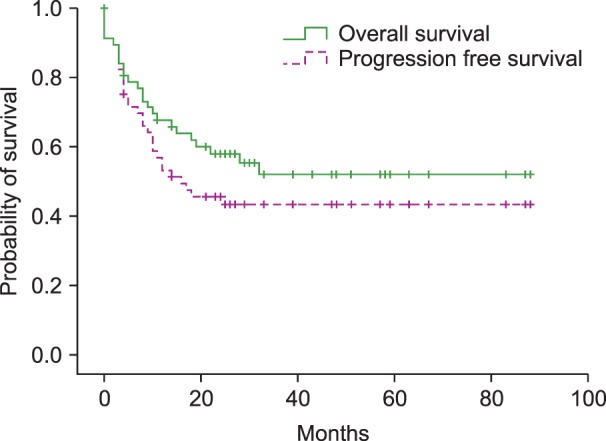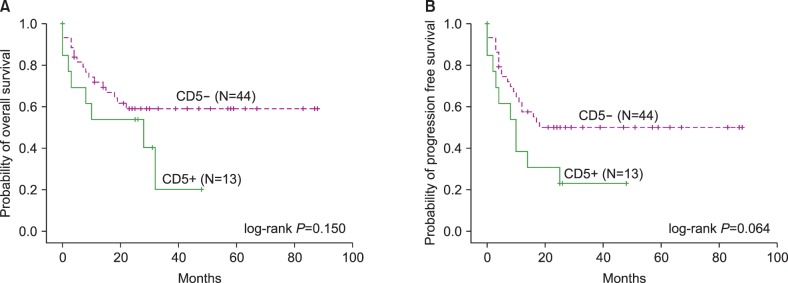Blood Res.
2017 Sep;52(3):193-199. 10.5045/br.2017.52.3.193.
Clinical impact of CD5 expression in Korean patients with diffuse large B-cell lymphoma
- Affiliations
-
- 1Department of Laboratory Medicine and Genetics, Samsung Medical Center, Sungkyunkwan University School of Medicine, Seoul, Korea. sunnyhk@skku.edu
- 2Department of Laboratory Medicine, Gyeongsang National University Hospital, Gyeongsang National University School of Medicine, Jinju, Korea.
- 3Department of Laboratory Medicine and Genetics, Soonchunhyang University Bucheon Hospital, Soonchunhyang University College of Medicine, Bucheon, Korea.
- 4Division of Hematology-Oncology, Department of Medicine, Samsung Medical Center, Sungkyunkwan University School of Medicine, Seoul, Korea.
- KMID: 2390981
- DOI: http://doi.org/10.5045/br.2017.52.3.193
Abstract
- BACKGROUND
CD5-positive diffuse large B-cell lymphoma (CD5+ DLBCL) accounts for 5-10% of DLBCL cases and has poor patient outcomes. However, most studies on CD5+ DLBCL were performed in Japanese patients and only few data are available for Korean population. In this study, we investigated the clinical characteristics and prognostic impact of CD5 expression in Korean patients with bone marrow (BM) involvement of DLBCL.
METHODS
Patients who were initially diagnosed with BM involvement of de novo DLBCL from 2005 to 2013 were included. Clinicopathological features and outcomes of patients were compared between CD5+ and CD5 negative (CD5−) DLBCL.
RESULTS
Among a total of 57 patients, the number of patients with CD5+ and CD5− DLBCL were 13 and 44, respectively. Clinical and laboratory features of CD5+ DLBCL were not significantly different from those of CD5− DLBCL. The 3-year overall survival (OS) rates for CD5+ and CD5− DLBCL were 20.2% and 59.0%, respectively (P=0.031), and 3-year progression-free survival (PFS) rates for CD5+ and CD5− DLBCL were 23.1% and 50.1%, respectively (P=0.055).
CONCLUSION
CD5+ DLBCL with BM involvement showed an inferior survival tendency compared to CD5− DLBCL, and thorough evaluation of CD5 expression might be helpful to predict the prognosis of patients with DLBCL.
Keyword
MeSH Terms
Figure
Reference
-
1. Swerdlow SH, Campo E, Harris NL, editors. WHO classification of tumours of haematopoietic and lymphoid tissues. 4th ed. Lyon, France: IARC Press;2008.2. Yi HG, Kim JS, Suh C, et al. Clinical features and survival outcomes of patients with diffuse large B-cell lymphoma: analysis of web-based data from the Korean Lymphoma Working Party Registry. Blood Res. 2013; 48:115–120. PMID: 23826580.
Article3. International Non-Hodgkin's Lymphoma Prognostic Factors Project. A predictive model for aggressive non-Hodgkin's lymphoma. N Engl J Med. 1993; 329:987–994. PMID: 8141877.4. Yamaguchi M, Ohno T, Oka K, et al. De novo CD5-positive diffuse large B-cell lymphoma: clinical characteristics and therapeutic outcome. Br J Haematol. 1999; 105:1133–1139. PMID: 10554834.
Article5. Yamaguchi M, Seto M, Okamoto M, et al. De novo CD5+ diffuse large B-cell lymphoma: a clinicopathologic study of 109 patients. Blood. 2002; 99:815–821. PMID: 11806981.
Article6. Ennishi D, Takeuchi K, Yokoyama M, et al. CD5 expression is potentially predictive of poor outcome among biomarkers in patients with diffuse large B-cell lymphoma receiving rituximab plus CHOP therapy. Ann Oncol. 2008; 19:1921–1926. PMID: 18573805.
Article7. Niitsu N, Okamoto M, Tamaru JI, et al. Clinicopathologic characteristics and treatment outcome of the addition of rituximab to chemotherapy for CD5-positive in comparison with CD5-negative diffuse large B-cell lymphoma. Ann Oncol. 2010; 21:2069–2074. PMID: 20231297.
Article8. Miyazaki K, Yamaguchi M, Suzuki R, et al. CD5-positive diffuse large B-cell lymphoma: a retrospective study in 337 patients treated by chemotherapy with or without rituximab. Ann Oncol. 2011; 22:1601–1607. PMID: 21199885.
Article9. Xu-Monette ZY, Tu M, Jabbar KJ, et al. Clinical and biological significance of de novo CD5+ diffuse large B-cell lymphoma in Western countries. Oncotarget. 2015; 6:5615–5633. PMID: 25760242.
Article10. Alinari L, Gru A, Quinion C, et al. De novo CD5+ diffuse large B-cell lymphoma: Adverse outcomes with and without stem cell transplantation in a large, multicenter, rituximab treated cohort. Am J Hematol. 2016; 91:395–399. PMID: 26800311.
Article11. Hans CP, Weisenburger DD, Greiner TC, et al. Confirmation of the molecular classification of diffuse large B-cell lymphoma by immunohistochemistry using a tissue microarray. Blood. 2004; 103:275–282. PMID: 14504078.
Article12. Yamaguchi M, Nakamura N, Suzuki R, et al. De novo CD5+ diffuse large B-cell lymphoma: results of a detailed clinicopathological review in 120 patients. Haematologica. 2008; 93:1195–1202. PMID: 18556402.
Article13. Yoshioka T, Miura I, Kume M, et al. Cytogenetic features of de novo CD5-positive diffuse large B-cell lymphoma: chromosome aberrations affecting 8p21 and 11q13 constitute major subgroups with different overall survival. Genes Chromosomes Cancer. 2005; 42:149–157. PMID: 15543600.
Article14. Chung R, Lai R, Wei P, et al. Concordant but not discordant bone marrow involvement in diffuse large B-cell lymphoma predicts a poor clinical outcome independent of the International Prognostic Index. Blood. 2007; 110:1278–1282. PMID: 17475910.
Article15. Chigrinova E, Mian M, Scandurra M, et al. Diffuse large B-cell lymphoma with concordant bone marrow involvement has peculiar genomic profile and poor clinical outcome. Hematol Oncol. 2011; 29:38–41. PMID: 20635329.
Article16. Park MJ, Park SH, Park PW, et al. Prognostic impact of concordant and discordant bone marrow involvement and cell-of-origin in Korean patients with diffuse large B-cell lymphoma treated with R-CHOP. J Clin Pathol. 2015; 68:733–738. PMID: 25998512.
Article17. Kajiura D, Yamashita Y, Mori N. Diffuse large B-cell lymphoma initially manifesting in the bone marrow. Am J Clin Pathol. 2007; 127:762–769. PMID: 17439835.
Article
- Full Text Links
- Actions
-
Cited
- CITED
-
- Close
- Share
- Similar articles
-
- Transformation of CD5-Negative Follicular Lymphoma into CD5-Positive Diffuse Large B-Cell Lymphoma: A Case Report
- De novo CD5 Positive Diffuse Large B-cell Lymphomas with Bone Marrow Involvement in Korean
- The Expression of p16 in Diffuse Large B-cell Lymphoma and Its Prognostic Implications
- Relapse of Ocular Lymphoma following Primary Testicular Diffuse Large B-cell Lymphoma
- De Novo CD5-Positive Primary Gastric Diffuse Large B-Cell Lymphoma Coexpressing MYC and BCL6: Towards a Proper Subset of Double-Hit, Triple-Hit and, Maybe, Quadruple-Hit B-Cell Lymphomas?



